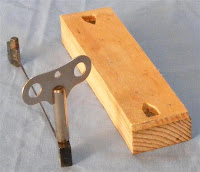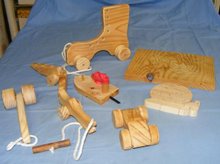Let's get down and dirty
Cob oven for cheapskates
Whatjaneed:
Dirt (subsoil) (75% sand, 25% clay is good)
Sand (for the dome formwork)
Straw (cut into pieces)
Water (for mixture)
Cement (for mortar)or mortar mix
Rocks
Filling
Bucket/lid for storage of faggots (small wood)
Old bucket (acts as filling)
Bricks (do not need to be fire bricks)
Newspaper
Step 1
Pick a site to build.
Find the place that is in the sun ![]()
Step 2
Start laying out your rocks in the shape you want, as big as you want. If I made another one, it would be much bigger.
Mortar your rocks together using a mortar mix.
Keep going and build up until you reach the required height.
I inserted a bucket with a sealable lid to store the wood required to fire the oven.
Step 3
Level the top with sand and lay your bricks.
When the chooks heard I was going to lay bricks they were quite interested. ![]()
Measure out the dome size according to how many pizza trays or bread pans that you want to use.
Start building your dome. The bucket allows you to fill without using too much sand.
Step 4
When you have your shape, cover in wet newspaper this allows you to see where your mould starts and your cob stuff begins.
Step 5
Mix your cob stuff with a mix of 75% sand and 25% clay and some chopped up straw.
If you are a hippy, you can do the barefoot-on-the-canvas-dance. I am a hippy but an old one. I used a mixer.
Step 6
Make a ball from your mix and proceed to build up your cob layers around the dome.
I made basically three layers:
1 the first was a dense dense thermal layer
2 the middle, a less dense layer with straw and finally
3 the finish layer.
All up, about 60mm thick. Remember, the thicker the wall the more wood (lumber for our OS cousins) needed to warm it up, but then it will keep warm for a long time.
Step 7
Allow the whole construction to dry for a week or two.
Empty the dome out. Note how much sand you used!
There you have it. Finish as desired. I just bunged cob around the base. Looks like a dalek ![]()
Step 8
Set up your fire (boy/girl scouts should have no problems here)
Light it. You should allow about five hours before the oven is ready for use.
Note, you fire up with the door off. You cook with the door on.
Step 9
It was my first firing and we managed to cook up 4 pizzas (nice), 4 calzone (delicious) and scones (reeeaally nice).
In the collage you may note that the before piccy of the pizzas has a notebook handy.
I kept track of the temp every half hour to see what sort of temps the oven keeps.
If I knew that it kept its heat so high for so long, I would have had more stuff to cook including bread and a casserole or baked veggies.
Maybe next time. ![]()
Yours in cobness, Doc ![]()
9th September 2009
I have edited to add the following because not everybody reads the comments:
After the first firing of burning for 3-4 hours the temp when the coals were raked back and some removed was over 250*c (oven thermometer only goes to 250*c) so:
1130 hrs over 250*c - pizzas in, cook for 3-4 minutes did heaps to freeze for later
1400 hrs 230*c respread coals cook scones and calzone, more coals removed
1530 hrs 110*c
1545 hrs 110*c
1600 hrs 110*c
1700 hrs 100*c
1730 hrs 100*c
1800 hrs 80*c This was now the mass provided the heat as all the coals were removed because I did not have any more food prepared LOL
2000 hrs 80*c
2400 hrs 60*c Good time to roast some veg or a chook etc etc
0500 hrs next morning 20*c ready to be refired if required.
Get stuck in to making the oven and then work out what you want to cook all day and overnight.
Later firings were a lot more relaxed affairs but I did not keep any temps.
How this helps with temperature guides.
Doc ![]()






































